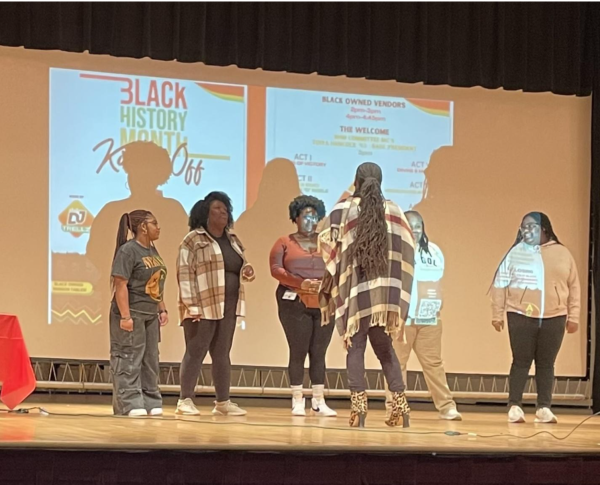IEC’s House of Straight/Cis Privilege provokes discussion about LGBTQIA+ representation at Guilford
Shiny dresses, colorful props and a wealth of laminated fact sheets lined the corridors of King Hall’s main floor this week, as the Intercultural Engagement Center’s House of Straight Privilege exhibit was on display for the second year in a row. The display seeks to draw attention to the various privileges straight/cis people enjoy everyday without thinking twice, as well as to spark discussion about LGBTQIA+ representation here at Guilford College.
In its first year, the House of Straight Privilege (HOSP) was planned over the course of eight weeks and had students from the Black History Month Commission, PRIDE and staff from the IEC working together on this detailed setup. This year, Krishauna Haines-Gaither, director of the IEC, did it all herself.
“We’re going to have this no matter what,” said Haines-Gaither, who spent six hours on a Friday evening pulling the exhibit together. Haines-Gaither says that once you stop doing things it becomes a lot easier to not start them up again, and she would not let HOSP become one of those things.
In the past, the House of Straight/Cis Privilege has hosted guided tours, with entire classes signing up. This year, it was a much more passive event.
Faculty and students get up to take a break, spot the colorful exhibit, and end up “tak(ing) a walk and get(ting) some education,” said Meagan McNeely, the former LGBTQIA+ coordinator for the IEC.
House of Straight/Cis Privilege was created with specific goals in mind. Haines-Gaither and McNeely both hope that this exhibit opens people’s eyes to the privileges enjoyed by straight people and implores them to take action. People are benefitting from a system “on the backs of those who are denied…and this is something we have to wrestle with,” said Haines-Gaither. “(For one to) go and make their classes and workplaces and homes (even) a little more comfortable for the (LGBTQIA+) community… taking action is the main goal,” McNeely added.
HOSP is unique in its multilayered setup. The “house” concept is taken in all its definitions; childhood home, workplace, relationships, domestic life, house of worship and more are represented through individual displays. Key tokens of those environments add to the physical aspect, such as childhood toys and a workplace computer.
“We want (this exhibit) to pierce not just the mind and the soul, but also the body… with visual props, (one can) experience the exhibit in multiple dimensions,” said Haines-Gaither.
Terra Roane, director of the Office of Student Leadership and Engagement (OSLE) who toured the setup, felt these effects.
“I found the layout thoughtful, creative, full of expression, emotion and data,” said Roane. “It appealed to all cognitive ways of processing information.”
On top of the three dimensional aspect, HOSP is also unique for the sizable amount of statistics and data on LGBTQIA+ oppression pasted all over the hall. One card cites a study finding that “57% of LGBTQ adults experienced slurs or offensive comments.”
McNeely says that researching for the fact sheets was a twofold experience. It was scary to see how disproportionately harder it is for an LGBTQIA+ person to live. But it was also validating to see irrefutable data on the struggles of the community.
“This is real stuff that real humans experience… significant enough (that it has been) researched on,” says McNeely.
“The statistical data truly brought to light the alarming rates that are not present in everyday media outlets,” said Roane.
Sadandre’ Jackson, graduate assistant at the OSLE, attended this event and learned “about what I can do to raise awareness and raise love for (trans women of color and trans non-binary humans).”
House of Straight/Cis Privilege also provoked discussion, among the coordinators and attendees alike, on Guilford College’s support for and representation of the LGBTQIA+ community.
According to the Campus Pride Index, Guilford College ranks a five out of five on institutional commitment to LGBTQ+ inclusivity; one of only two colleges in the state to achieve that ranking. It is also ranked one of the top 30 LGBTQ+ friendly colleges.
While McNeely and Haines-Gaither both agree that Guilford is overall supportive of the LGBTQIA+ community, Haines-Gaither also believes that “queer people of color do not feel as supported.”
Viewers of the exhibit interviewed also generally agreed that Guilford College tries to provide a supportive, inclusive environment, but there is room for improvement.
“It was surprising to me that there is no physical safe space solely dedicated to these students where they can be protected, can think and can simply exist,” said Jackson. “Everyone needs someone. I would love to see a center or office for these students that they can call home.”
The COVID-19 pandemic has made initiatives towards inclusivity more difficult, with Guilford College’s LGBTQIA+ coordinator being laid off due to financial stress as well as limited resources to support the community.
However, the Intercultural Engagement Center hopes that by continuing to host events like House of Straight/Cis Privilege during this difficult time, and by making their enthusiasm to support the LGBTQIA+ community – particularly queer people of color – known, they can work towards establishing an environment where no one feels the need to hide who they are and who they love.







